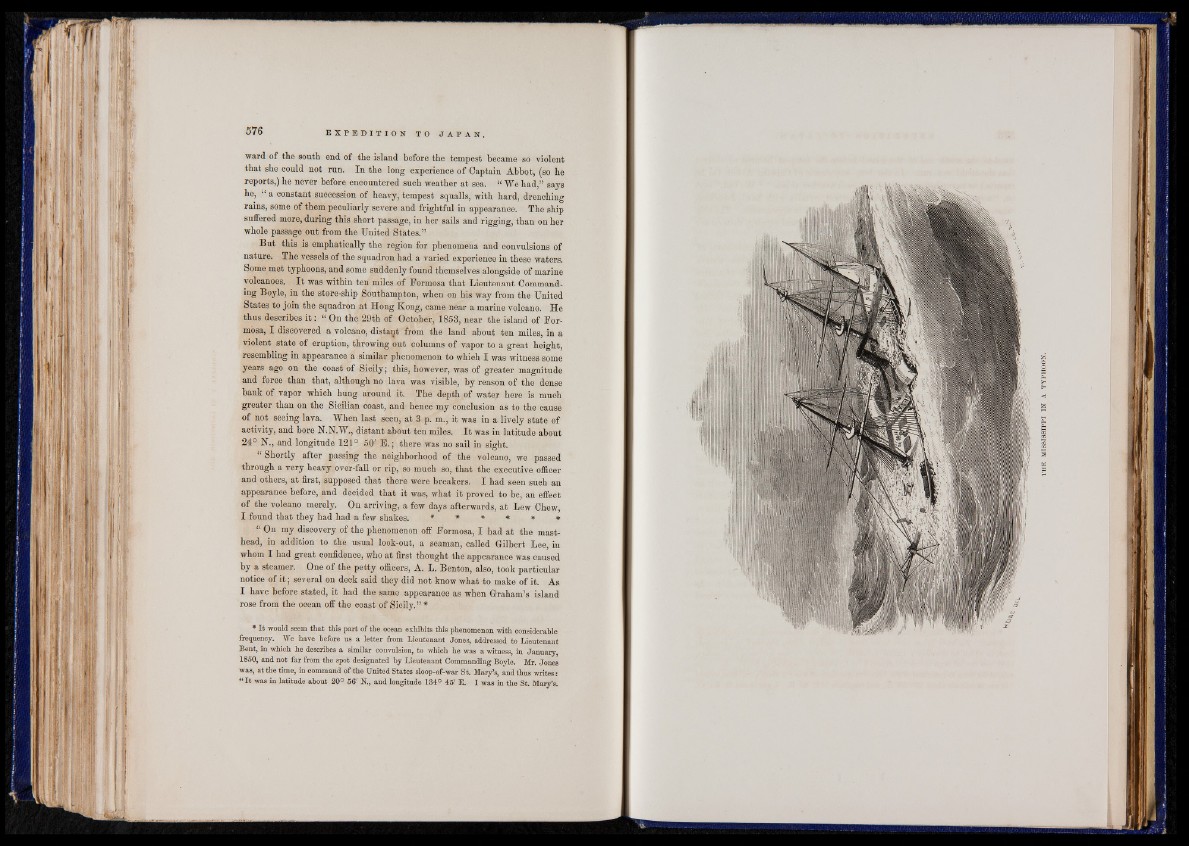
ward of the south end of the island before the tempest became so violent
that she could not run. In the long experience of Captain Abbot, (so he
reports,) he never before encountered such weather at sea. “ We had,” says
he, “ a constant succession of heavy, tempest squalls, with hard, drenching
rains, some of them peculiarly severe and frightful in appearance. The ship
suffered more, during this short passage, in her sails and rigging, than on her
whole passage out from the United States.”
But this is emphatically the region for phenomena and convulsions of
nature. The vessels of the squadron had a varied experience in these waters.
Some met typhoons, and some suddenly found themselves alongside of marine
volcanoes. I t was within ten miles of Formosa that Lieutenant Commanding
Boyle, in the store-ship Southampton, when on his way from the United
States to join the squadron at Hong Kong, came near a marine volcano. He
thus describes i t : “ On the 29th of October, 1853, near the island of Formosa,
I discovered a volcano, distant from the land about ten miles, in a
violent state of eruption, throwing out columns of vapor to a great height,
resembling in appearance a similar phenomenon to which I was witness some
years ago on the coast of Sicily; this, however, was of greater magnitude
and force than that, although no lava was visible, by reason of the dense
hank of vapor which hung around it. The depth of water here is much
greater than on the Sicilian coast, and hence my conclusion as to the cause
of not seeing lava. When last seen, at 3 p. m., it was in a lively state of
activity, and bore N.N.W., distant about ten miles. I t was in latitude about
24° N., and longitude 121° 50' E .; there was no sail in sight.
“ Shortly after passing the neighborhood of the volcano, we passed
through a very heavy over-fall or rip, so much so, that the executive officer
and others, at first, supposed that there were breakers. I had seen such an
appearance before, and decided that it was, what it proved to be, an effect
of the volcano merely. On arriving, a few days afterwards, at Lew Chew,
I found that they had had a few shakes. * * * * * *
“ On my discovery of the phenomenon off Formosa, I had at the masthead,
in addition to the usual look-out, a seaman, called Gilbert Lee, in
whom I had great confidence, who at first thought the appearance was caused
by a steamer. One of the petty officers, A. L. Benton, also, took particular
notice of it; several on deck said they did not know what to make of it. As
I have before stated, it had the same appearance as when Graham’s island
rose from the ocean off the coast of Sicily.” *
* I t would seem that this part of the ocean exhibits this phenomenon with considerable
frequency. We have before us a letter from Lieutenant Jones, addressed to Lieutenant
Bent, in which he describes a similar convulsion, to which he was a witness, in January,
1850, and not far from the spot designated by Lieutenant Commanding Boyle. Mr. Jones
was, at the time, in command of the United States sloop-of-war St. Mary’s, and thus writes:
“ I t was in latitude about 20° 56' N., and longitude 134° 45' E. I was in the St. Mary’s.